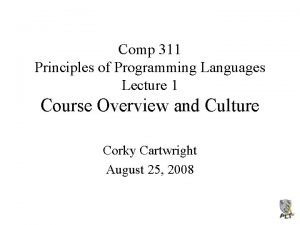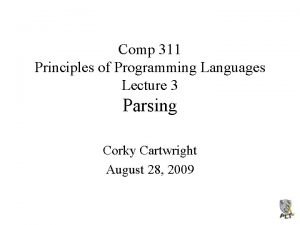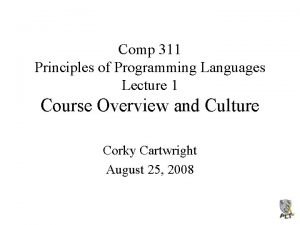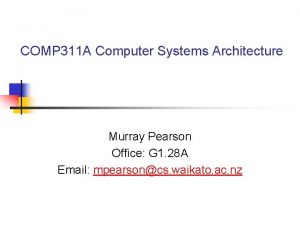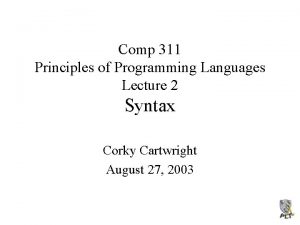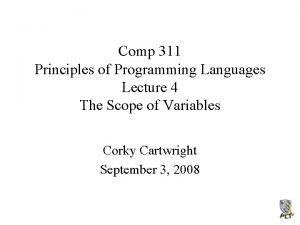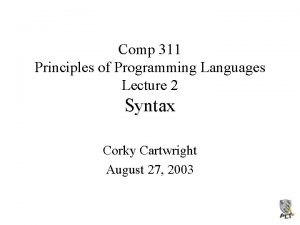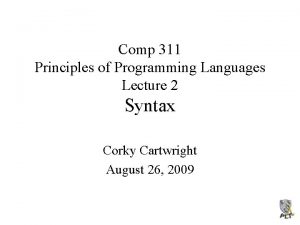Comp 311 Principles of Programming Languages Lecture 2








- Slides: 8

Comp 311 Principles of Programming Languages Lecture 2 Syntax Corky Cartwright August 26, 2009

Syntax: The Boring Part of Programming Languages • Programs are represented by sequences of symbols. • These symbols are represented as sequences of characters that can be typed on a keyboard (ASCII). • What about Unicode? • To analyze or execute the programs written in a language, we must translate the ASCII representation for a program to a higher-level tree representation. This process, called parsing, conveniently breaks into two parts: – lexical analysis, and – context-free parsing (often simply called parsing).

Lexical Analysis • Consider this sequence of characters: begin middle end • What are the smallest meaningful pieces of syntax in this phrase? • The process of converting a character stream into a corresponding sequence of meaningful symbols (called tokens or lexemes) is called tokenizing, lexing or lexical analysis. A program that performs this process is called a tokenizer, lexer, or scanner. • In Scheme, we tokenize (set! x (+ x 1)) as ( set! • x ( + x 1 ) ) Similarly, in Java, we tokenize System. out. println("Hello World!"); as System. out. println ( "Hello World!" ) ;

Lexical Analysis, cont. • Tokenizing is straightforward for most languages because it can be performed by a finite automaton [regular grammar] (Fortran is an exception!). – The rules governing this process are (a very boring) part of the language definition. • Parsing a stream of tokens into structural description of a program (typically a tree) is harder.

Parsing • Consider the Java statement: x = x + 1; where x is an int variable. • The grammar for Java stipulates (among other things): – The assignment operator = may be preceded by an identifier and must be followed by an expression. – An expression may be two expressions separated by a binary operator, such as +. – An assignment expression can serve as a statement if it is followed by the terminator symbol ; . Given all of the rules of this grammar, we can deduce that the sequence of characters (tokens) x = x + 1; is a legal program statement.

Parsing Token Streams into Trees • Consider the following ways to express an assignment operation: x=x+1 x : = x + 1 (set! x (+ x 1)) • Which of these do you prefer? • It should not matter very much. • To eliminate the irrelevant syntactic details, we can create a data representation that formulates program syntax as trees. For instance, the abstract syntax for the assignment code given above could be (make-assignment <Rep of x> <Rep of x + 1>) • or new Assignment(<Rep of x> , <Rep of x + 1>)

A Simple Example Exp : : = Num | Var | (Exp Exp) | (lambda Var Exp) Num is the set of numeric constants (given in the lexer specification) Var is the set of variable names (given in the lexer specification) • To represent this syntax as trees (abstract syntax) in Scheme ; exp : = (make-num number) + (make-var symbol) + (make-app exp) + ; (make-proc symbol exp) (define-struct (num n)) (define-struct (var s)) (define-struct (app rator rand)) (define-struct (proc param body)) ; ; param is a symbol not a var – app represents a function application – proc represents a function definition • In Java, we represent the same data definition using the composite pattern

Top Down (Predictive) Parsing Idea: design the grammar so that we can always tell what rule to use next starting from the root of the parse tree by looking ahead some small number [k] of tokens (formalized as LL(k) parsing). Can easily be implemented by hand by writing one recursive procedure for each syntactic category (non-terminal symbol). The code in each procedure matches the token pattern of the right hand side of the rule for that procedure against the token stream. This approach to writing a parser is called recursive descent. Conceptual aid: syntax diagrams to express context free grammars. Recursive descent and syntax diagrams are discussed in next lecture.
